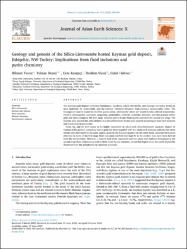Geology and genesis of the Silica-Listwaenite hosted Kaymaz gold deposit, Eskişehir, NW-Turkey: Implications from fluid inclusions and pyrite chemistry
Künye
Yavuz, H., Demir, Y., Kasapci, C., Uysal, I. & Helvaci, C. (2022). Geology and genesis of the Silica-Listwaenite hosted Kaymaz gold deposit, Eskişehir, NW-Turkey: Implications from fluid inclusions and pyrite chemistry. Journal of Asian Earth Sciences: X, 8, 100104. https://doi.org/10.1016/j.jaesx.2022.100104Özet
The Kaymaz gold deposit comprises Damdamca, Karakaya, Küçük Mermerlik, and Kızılağıl ore zones within an area underlain by serpentinite and far-traveled Paleozoic-Mesozoic high-pressure metamorphic rocks. The Kızılağıl ore zone is hosted in silicified quartz schist, whereas the others are hosted in silica altered serpentinite. Pyrite-I, arsenopyrite, marcasite, magnetite, pentlandite, millerite, nickeline, bravoite, and fine-grained native gold and silver comprise the first stage, whereas pyrite-II and chalcopyrite represent the second ore stage. The Kaymaz gold deposit has been defined as a silica-listwaenite hosted gold deposit according to host rock relations and mineralogical properties. Gold, Ag, and As were found to be highly correlative in whole-rock silica-listwaenite analyses. Higher As content of the pyrite-I, coexisting native gold and silver together with the whole-rock analyses indicate that these metals were derived from the same source, possibly the Kaymaz granite. On the other hand, clathrate formations observed in some of the first stage fluid inclusions confirm that high Ni in the pyrite-I may have been derived from the serpentinites. However, a distinct lack of the separated carbonic phase and clathrate formations in the second stage fluid inclusions as well as their lower Th and salinities, reveal that higher Co in the pyrite-II possibly dissolved from the metabasites by meteoric solutions.


















